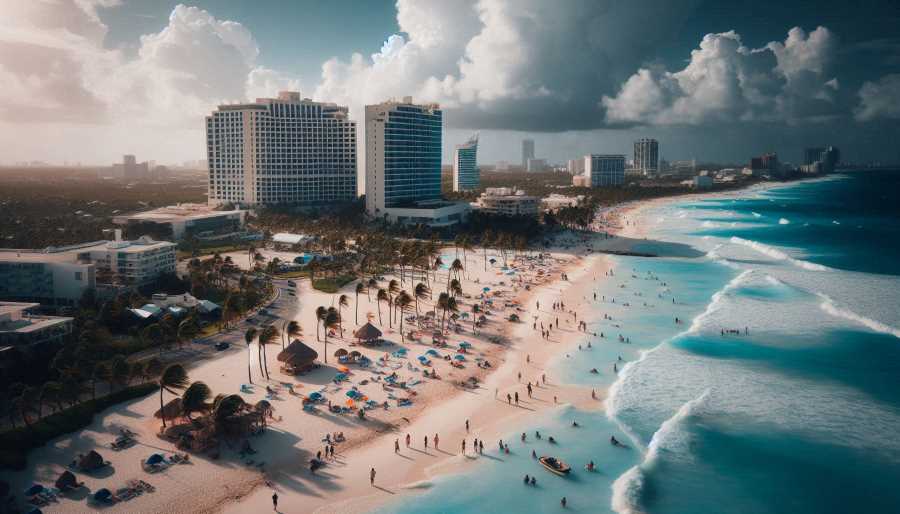Cancun Recovers from Hurricane Helene's Impact
Hurricane Helene caused significant damage in Quintana Roo, Mexico. Authorities are working to restore normalcy. Cancun airport has resumed operations, while emergency relief efforts continue on Holbox.

In the wake of tropical storm Helene, Quintana Roo is beginning to pick up the pieces, as both locals and tourists face the consequences of the storm's heavy rains and gusting winds. While the state’s iconic Cancun International Airport has gradually resumed operations, delays and cancellations linger in the aftermath of a disruption that hit at the height of the region’s tourist season. As Governor Mara Lezama reported, authorities are working to restore normalcy across Quintana Roo, including at key ports and popular destinations like Cozumel and Tulum, but the scars left by Helene are evident.
Helene made its presence felt across Quintana Roo, with the storm hitting hardest in the state’s tourism hub, Cancún. As of late Wednesday afternoon, the Cancun International Airport was still facing significant disruption: 46 incoming flights were delayed, along with 49 outbound, and a staggering 108 flights were canceled. Passengers faced confusion and uncertainty, as the storm's effects rippled across the aviation industry. By Thursday morning, operations began to stabilize, with Mara Lezama announcing that gradual reactivation was underway, and hopes were high that full operations could resume before the day ended.
However, not all transport routes were as hampered. The key maritime terminals across Tulum, Cozumel, and Chetumal are operating without major setbacks, a hopeful sign of the region’s resilience. The announcement of the return of cruises to Cozumel, highlighted by the arrival of the Carnival Jubilee, signals that while recovery may take time, tourism is preparing to return in full swing.
Cancun itself was pummeled by torrential downpours and winds, leaving parts of the city submerged. The hotel zone's bustling boulevard Kukulkán was overwhelmed, particularly at the 9.5-kilometer mark, where the streets surrounding the famous nightlife district became impassable. The flooding forced many establishments to close, with water levels rising to the point where sidewalks overflowed, and the interiors of bars and clubs were compromised. Despite the inundation, tourists largely remained in their hotels, as many of the island’s hospitality venues acted as makeshift shelters to weather the storm.
Elsewhere in Quintana Roo, such as in Isla Mujeres, the impacts were even more severe. The island’s central area saw widespread flooding, leaving streets entirely submerged and homes and businesses facing extensive water damage. Power outages were another challenge, with large sections of the island plunged into darkness. According to the Federal Electricity Commission (CFE), a total of 122,889 residents were left without power across the state, although progress was made swiftly. As of Wednesday evening, CFE had managed to restore service to 22,807 users, but the majority of the island remained in the dark.
Holbox, the quiet, eco-conscious island popular with travelers seeking a more off-the-beaten-path experience, also suffered greatly. Emergency crews and the Quintana Roo Potable Water and Sewer Commission (CAPA) worked tirelessly to assist those impacted, with flooding exacerbating the already delicate infrastructure on the island. The efforts to clear roads and remove debris from ports and terminals are ongoing, with particular attention given to the more isolated and vulnerable areas.
Perhaps one of the hardest-hit sectors has been Cancun’s restaurant industry. With many of the city’s streets and avenues under water, 95% of the city’s restaurants were forced to remain closed, according to the president of the National Chamber of the Restaurant Industry and Seasoned Foods (Canirac), José Julio Villareal. The deluge rendered kitchens in both the hotel zone and the downtown area inoperable, as leaks, blackouts, and blocked roads created insurmountable challenges for most restaurateurs.
Helene’s arrival comes at an especially tough time for the industry, which was already reeling from the lingering economic effects of the COVID-19 pandemic. Restaurants that managed to stay open faced a drastic reduction in foot traffic due to the hazardous conditions outside. For small, independently owned kitchens and taco stands—many of which rely heavily on daily income to survive—the situation is particularly dire. Business owners are now not only assessing damage from flooding but also grappling with the uncertainty of when they can reopen and how they can recover lost revenue. Canirac is actively working with local authorities to explore options for economic support, hoping for government assistance to help these businesses rebuild.
Recovery Amidst the Chaos
Despite the devastation, Quintana Roo’s road to recovery has begun. Public transportation and bus companies, such as ADO, are back in operation, signaling the restoration of mobility in the northern part of the state. The passenger routes from Puerto Juárez to Isla Mujeres, operated by Ultramar Ferry, and from Calica to Cozumel, run by Transcaribe, have also resumed, offering a sense of normalcy for locals and tourists alike.
Street vendors, an integral part of Quintana Roo's bustling street economy, have also shown remarkable resilience. While many paused their activities as a precaution, Paloma Ortega Cuervo, General Secretary of the Union of Street Vendors, expressed optimism about a quick return to business. With many vendors taking Wednesdays off regularly, they faced only minimal disruption and are expected to resume operations by Thursday, provided conditions improve.
However, as the region strives for recovery, the weather remains unpredictable. The authorities have warned that heavy rains, gusting winds, and rough seas may continue to affect the northern parts of the state in the coming hours. With a yellow alert still in place for potential further impacts from Helene, residents and tourists are being urged to remain vigilant, take necessary precautions, and stay informed through official channels.
While the economic losses—particularly in Cancun’s restaurant and hospitality sectors—are significant, the rapid response from local authorities, emergency services, and community leaders has minimized what could have been a far more devastating blow to this crucial tourist destination. With the gradual reactivation of services and transport, there is hope that Quintana Roo’s vital tourism industry will recover, even as it navigates the difficult road ahead.




